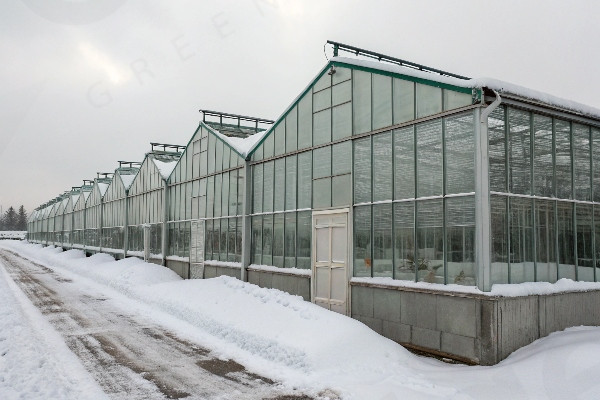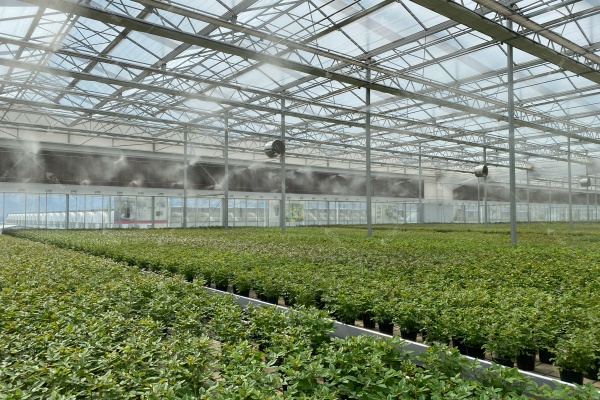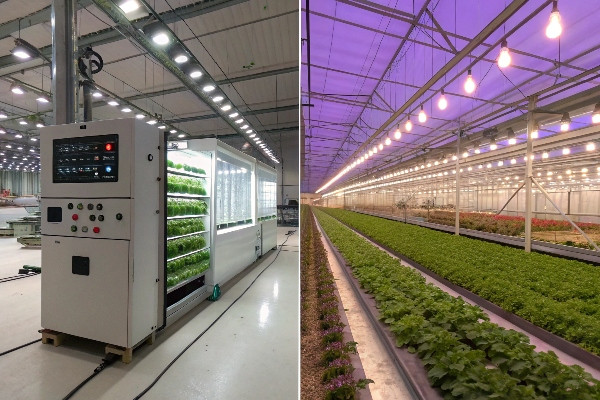You’re planning your greenhouse project, but foundation choices feel overwhelming. Poor foundation decisions can cost thousands and destroy your investment within years.
After 29 years of greenhouse construction across 20+ countries, I’ve learned that the right foundation determines whether your greenhouse thrives for decades or fails within seasons. Your structure type, climate, and soil conditions dictate everything.

I remember my first major greenhouse project in Thailand back in 2000. The client chose the cheapest foundation option against my advice. Within two monsoon seasons, we were rebuilding everything. That expensive lesson taught me why foundation selection can make or break any greenhouse investment.
Don’t Miss:——Commercial Hydroponic Greenhouse Systems: How Do Design, Construction, and ROI Interconnect?
You might like:——What is a Smart Greenhouse? The Ultimate Guide to Automated Growing
Do All Greenhouses Need a Foundation? When It’s Necessary
Your greenhouse type determines foundation requirements. Many growers assume all structures need identical foundation approaches. This misconception costs money and creates unnecessary complications.
Not every greenhouse requires a full foundation. Single-span arched greenhouses often work with minimal ground preparation, while multi-span structures demand reinforced foundations for long-term stability and performance.
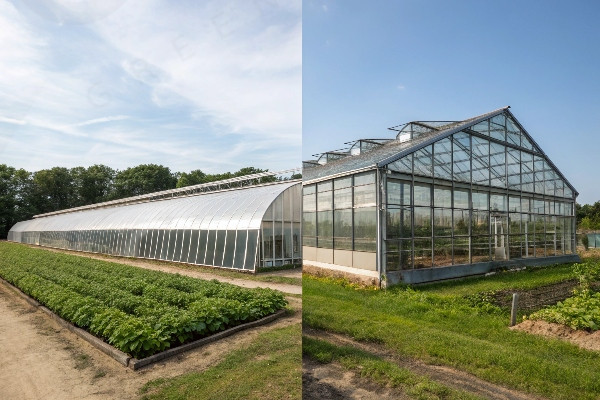
I’ve worked with countless greenhouse projects where clients wanted to over-engineer small structures or under-prepare large installations. The truth is simpler than most people think. Single-span arched greenhouses have inherent stability due to their compact footprint and self-supporting design. These structures distribute weight evenly across their base, creating natural stability that doesn’t always require extensive foundation work.
However, I always recommend inserting these structures 40 to 50 centimeters underground, even when full foundations aren’t necessary. This depth provides anchor points that prevent wind uplift and seasonal ground movement from affecting your structure. I learned this the hard way during a project in Kazakhstan, where extreme temperature swings caused ground heaving that shifted an inadequately anchored greenhouse by nearly a meter.
For larger multi-span greenhouses, comprehensive foundations become essential. These structures create concentrated load points where columns meet the ground. Without proper foundation support, soil settlement becomes inevitable. I’ve seen multi-million dollar greenhouse facilities in the Netherlands fail because owners tried to save money on foundations. The resulting structural damage cost five times more than proper foundations would have cost initially.
The decision point comes down to structure size, expected lifespan, and local conditions. Small hobby greenhouses might work with simple ground preparation, but commercial operations require foundations that match building standards. Climate plays a crucial role too. Areas with freeze-thaw cycles, high winds, or unstable soils always need reinforced foundations regardless of greenhouse size.
Comparing Greenhouse Foundation Types: Soil, Gravel, Concrete, Wood
Foundation materials each offer distinct advantages depending on your specific situation. Choosing wrong materials creates long-term maintenance headaches and structural issues. Smart material selection saves money while ensuring stability.
Concrete provides maximum durability and load-bearing capacity, gravel offers excellent drainage with moderate stability, wood gives flexibility for temporary installations, while direct soil placement works only for specific lightweight structures.
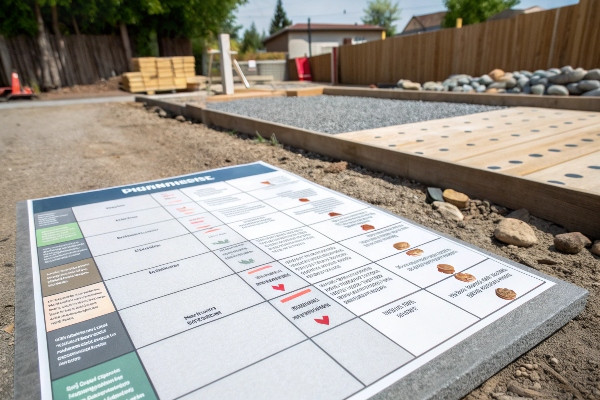
Concrete Foundations: The Gold Standard
Concrete foundations represent the most reliable choice for permanent greenhouse installations. I specify concrete for all commercial projects because it handles heavy loads, resists weather extremes, and provides decades of maintenance-free service. The initial cost seems high, but concrete foundations typically last 50+ years with minimal maintenance.
I remember a project in Finland where we installed concrete foundations for a research greenhouse in 2001. Despite 20+ years of harsh winter conditions with temperatures dropping to -35°C, those foundations remain perfectly level and crack-free. The greenhouse above continues operating at peak efficiency because the foundation provides unwavering stability.
Concrete works especially well in areas with expansive soils or extreme weather conditions. The mass and strength resist ground movement that would damage other foundation types. For multi-span greenhouses, concrete piers or continuous footings distribute loads effectively while providing anchor points for structural connections.
Gravel Foundations: Balanced Performance
Gravel foundations offer excellent drainage while providing stable support for medium-sized structures. I often recommend gravel for greenhouse projects in areas with good natural drainage but occasional moisture concerns. The material costs less than concrete while offering superior performance compared to soil-only installations.
A project in Vietnam taught me about gravel’s drainage benefits. The site experienced seasonal flooding, but our gravel foundation kept the greenhouse level and dry throughout monsoon seasons. The gravel layer acts like a natural drain field, moving water away from the structure while maintaining stability.
Gravel works best when properly contained with landscape fabric or retaining borders. Without containment, the material gradually spreads and loses effectiveness. I always specify angular gravel rather than rounded stone because angular pieces lock together better and resist displacement under load.
Wood Foundations: Temporary Solutions
Wood foundations work for temporary or semi-permanent installations where flexibility matters more than longevity. I’ve used pressure-treated lumber for greenhouse projects that needed future relocation or modification. Wood foundations cost less initially and allow easy adjustments as needs change.
However, wood foundations require regular maintenance and eventual replacement. Even pressure-treated materials degrade over time, especially in humid greenhouse environments. I typically estimate 10-15 year lifespans for wood foundations in optimal conditions, less in challenging climates.
Direct Soil Placement: Limited Applications
Some lightweight structures can sit directly on prepared soil, but this approach has narrow applications. I only recommend soil-only installations for small hobby greenhouses in stable soil conditions. Even then, proper soil preparation and drainage considerations remain essential.
How to Prepare the Ground for Your Greenhouse Foundation
Proper ground preparation determines foundation success regardless of materials chosen. Skipping preparation steps creates problems that compound over time. Thorough site preparation prevents most foundation failures before they start.
Start with soil testing, excavate to proper depths, ensure adequate drainage, compact base materials, and verify level grades. Each step builds upon previous work to create stable, long-lasting foundation support.
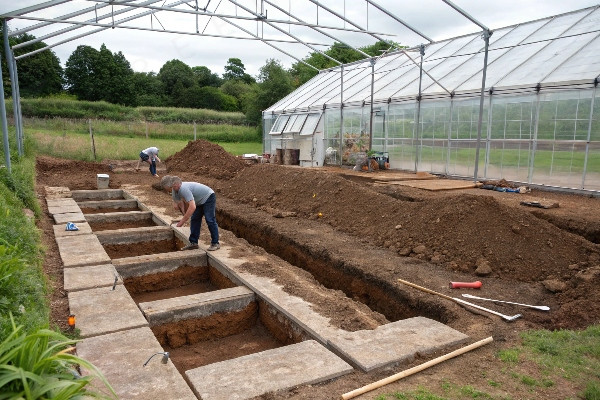
Site Assessment and Soil Testing
Every foundation project starts with understanding what lies beneath your greenhouse location. I always conduct soil tests to determine bearing capacity, drainage characteristics, and potential settlement issues. Soil conditions vary dramatically even within small areas, making testing essential for proper foundation design.
I learned this lesson during a project in Morocco where soil conditions changed from stable clay to loose sand within 20 meters. Our initial foundation design worked perfectly for the clay area but required significant modifications for the sandy section. Soil testing revealed these differences before construction, saving thousands in remedial work.
Professional soil tests cost a few hundred dollars but prevent expensive foundation failures. The tests reveal soil bearing capacity, which determines how much weight your foundation can support safely. They also identify expansive soils that swell and shrink with moisture changes, requiring special foundation techniques.
Excavation and Site Clearing
Proper excavation removes organic materials that decompose and create voids under foundations. I specify removing all topsoil, vegetation, and organic debris to reach stable subsoil. The excavation depth depends on your foundation type and local frost line requirements.
In areas with freeze-thaw cycles, foundations must extend below the frost line to prevent heaving damage. This might mean excavating 1-2 meters deep in northern climates. I always check local building codes for minimum depth requirements, then add safety margins for agricultural structures.
Site clearing includes removing trees, shrubs, and large rocks that could interfere with construction or create future problems. Tree roots continue growing after cutting and can eventually damage foundations. I recommend removing all vegetation within 3 meters of proposed greenhouse locations.
Drainage Considerations
Water management around greenhouse foundations prevents most long-term problems. Poor drainage causes soil erosion, foundation settlement, and structural damage. I design drainage systems during foundation planning rather than adding them later as afterthoughts.
Proper drainage starts with site grading that directs water away from the greenhouse. The finished grade should slope at least 2% away from the structure in all directions. This seemingly small detail prevents water accumulation that can undermine foundations over time.
Subsurface drainage becomes necessary in areas with high water tables or clay soils that hold moisture. French drains or gravel drainage layers help remove excess water before it affects foundation stability. I often specify perforated drainage pipes around greenhouse perimeters in challenging locations.
Base Material Preparation and Compaction
The foundation base requires careful preparation regardless of final foundation material. I specify crushed stone or gravel base layers that provide stable, well-draining support for concrete, wood, or additional gravel foundations. Proper compaction ensures this base layer performs as designed.
Compaction requires mechanical equipment for best results. Hand tamping works for small areas, but larger projects need plate compactors or vibratory rollers. I test compaction with simple tools – properly compacted base materials resist penetration from sharp objects and feel solid underfoot.
Base material thickness depends on soil conditions and expected loads. Typical installations need 15-20 centimeters of compacted base material, but challenging soils might require 30+ centimeters. The investment in proper base preparation pays dividends through decades of stable foundation performance.
Factors Influencing Your Greenhouse Foundation Choice (Size, Climate, Budget)
Multiple factors interact to determine optimal foundation choices for your specific situation. Understanding these relationships helps you make informed decisions that balance performance, cost, and long-term value. Smart planning considers all factors together rather than optimizing single variables.
Greenhouse size affects load distribution and foundation complexity, climate determines material durability requirements, local soil conditions influence foundation depth and design, while budget constraints require balancing initial costs against long-term performance and maintenance needs.
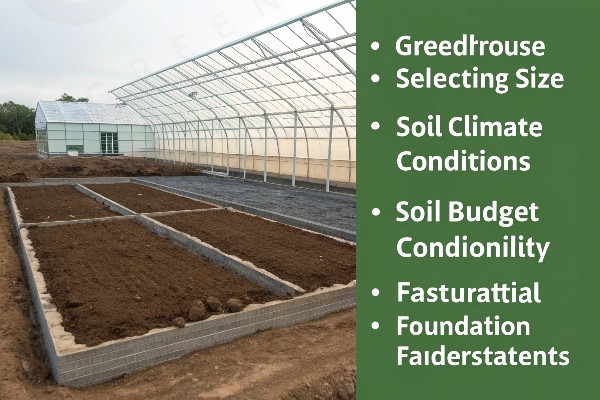
Size and Structural Load Considerations
Greenhouse size directly impacts foundation requirements through load distribution and structural complexity. Small single-span structures create relatively simple foundation demands, while large multi-span facilities require engineered foundation systems that handle concentrated loads and expansion joints.
I approach foundation design differently for structures under 100 square meters versus facilities covering thousands of square meters. Small greenhouses often work with simple perimeter foundations or pier systems, while large installations need comprehensive foundation networks that distribute loads safely across varying soil conditions.
Load calculations become critical for larger structures. Snow loads, wind loads, and equipment loads all transfer through the greenhouse frame to foundation elements. A commercial greenhouse in Canada might experience snow loads exceeding 100 kilograms per square meter, requiring foundations capable of handling these forces without settlement or failure.
Structural complexity increases exponentially with greenhouse size. Large facilities require expansion joints to accommodate thermal movement, which creates foundation design challenges. I’ve worked on projects where improper expansion joint design caused foundation cracking and structural damage as the facility expanded and contracted with temperature changes.
Multi-span greenhouses create concentrated loads at column locations that require individual foundation elements. These point loads stress foundations differently than distributed loads from smaller structures. Foundation design must account for these concentrated forces while maintaining level surfaces for proper greenhouse operation.
Climate Impact on Foundation Durability
Climate conditions determine material selection and foundation design requirements more than any other factor. Extreme temperatures, moisture cycles, and seasonal ground movement create specific challenges that foundation systems must handle reliably over decades of service.
Freeze-thaw cycles pose the greatest threat to greenhouse foundations in temperate climates. Water expansion during freezing creates tremendous forces that can crack concrete, shift foundation elements, and heave entire structures. I always design foundations to extend below local frost lines, but this basic requirement represents just the starting point for cold climate foundation design.
A project in Minnesota taught me about frost protection requirements1. Despite extending foundations below the theoretical frost line, extreme winter conditions drove frost deeper than expected. The greenhouse foundation heaved 15 centimeters, destroying the structure above. Now I add significant safety margins and install frost protection measures for all cold climate projects.
Hot climates create different challenges through thermal expansion and soil moisture variations. Concrete foundations in desert areas experience dramatic temperature swings that cause expansion and contraction stresses. I specify expansion joints and use concrete mixes designed for high-temperature performance in these applications.
Moisture patterns affect foundation performance through soil volume changes and drainage requirements. Areas with distinct wet and dry seasons often have expansive soils that swell when wet and shrink when dry. These volume changes create foundation movement that can damage greenhouse structures unless properly addressed through foundation design and drainage systems.
Coastal areas introduce salt exposure that accelerates foundation material degradation. Standard concrete mixes corrode quickly in salt environments, requiring special materials and protective measures. I’ve replaced entire foundation systems in coastal greenhouses where salt exposure wasn’t considered during initial design.
Budget Optimization Strategies
Foundation costs represent 15-25% of total greenhouse investment, making budget considerations crucial for project feasibility. However, cutting foundation costs often creates long-term expenses that exceed initial savings. Smart budget planning balances upfront investment against lifecycle costs and operational reliability.
I help clients understand foundation costs through lifecycle analysis rather than simple initial cost comparisons. A concrete foundation might cost twice as much as gravel initially but last three times longer with minimal maintenance. The concrete option actually costs less per year of service while providing superior performance.
Phased construction allows budget spreading for large projects. Foundation work can often accommodate future expansion if properly planned initially. I’ve designed foundation systems that support initial greenhouse installation while providing expansion capability for future growth. This approach reduces initial costs while avoiding expensive foundation modifications later.
Material selection offers significant budget optimization opportunities. Local materials typically cost less than imported alternatives while supporting regional suppliers. I always investigate local aggregate sources, concrete suppliers, and specialty materials that might reduce costs without compromising performance.
Labor costs vary significantly between foundation types. Simple gravel foundations require minimal skilled labor, while complex concrete systems need experienced crews and specialized equipment. Budget-conscious projects might choose foundation systems that allow owner participation in construction or use readily available local contractors.
Value engineering during design phases identifies cost reduction opportunities without performance compromises. Simple design changes like optimizing foundation depths, reducing concrete volumes, or eliminating unnecessary complexity can save significant money while maintaining structural integrity. I regularly find 10-20% cost reductions through careful value engineering2 analysis.
Conclusion
Your greenhouse foundation choice determines decades of performance and profitability. Consider structure type, climate conditions, and long-term costs when selecting foundation systems for lasting success.
Understanding frost protection is crucial for ensuring the longevity and stability of foundations in cold climates. Explore this resource for expert insights. ↩
Discover how value engineering can lead to significant cost savings while maintaining quality, a must-read for any construction project manager. ↩

